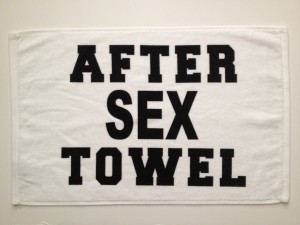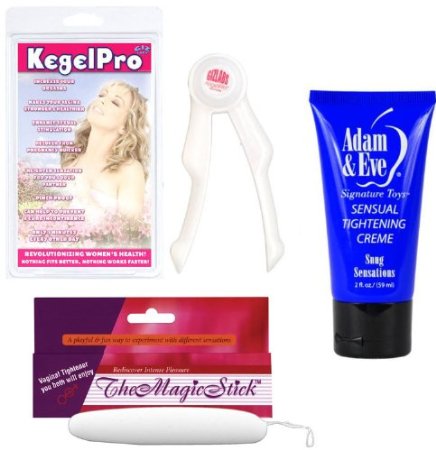Wednesday Bubble: Don’t just do kegels, do them like a pro!
I swear, I don’t mean to take a mick out of Kegel exercises; they have proven invaluable for regaining pelvic floor strength following pregnancy, disease and even in the case of stress incontinence. And yet, when I see a product like KegelPro, I simply can’t help myself.
KegelPro reminds of Suzanne Somer’s Thighmaster, a nifty product designed to reduce thigh size. Not surprisingly, the Thighmaster was marketed by the same guy who developed the Mood Ring (remember those)? But I digress.
KegelPro is being co-marketed in an exercise bundle an Amazon — not only do you get a nifty device that looks like a plastic speculum — but, it comes with the Magic Stick Vaginal Tightener, Adam & Eve Vaginal Tightening Lube & an After Sex Towel. Seriously, you can’t make this up. 
And the product description is even better:
“Exercise your way to make your vagina stronger and healthier. By using the Kegel Pro, you will enhance sexual stimulation, recover from pregnancy quicker and heighten sensations for you and your partner. All you have to do is concentrate on squeezing the muscles around the inserted Kegel Pro. Such an easy way to increase your orgasms! Works like magic! The Magic Stick is a vaginal tightening stick that helps to shrink the vaginal wall giving both partners a sensational feeling. With simple instruction for use and care, you will find this stick truly magical. Rediscover intense pleasure! Enjoy a fuller love life with Adam & Eve Sensual Tightening Creme! Use this vaginal tightening cream to increase chances of orgasm during sex, enhance your sexual performance, and grip every inch of your partner. Simply apply a liberal amount to your desired area. Squeeze tube with flip-top lid holds 2 oz. of creme. Get snug sensations tonight!”
By the way, KegelPro sells for $42. The package? $85. The product reviews? Priceless! Evidently this ‘Pharmaceutical grade piece of plastic’ is truly a novelty item. No wonder they threw the After Sex Towel into the deal.
Ladies – take Kegels seriously. The KegelPro? Bursting this bubble, even if it comes with a tamp…er, Magic Stick!
Read More
Estrogen and urinary incontinence: is there a link?
One of the most common and (and yet unspoken about) conditions in women is urinary incontinence (UI) or problems with bladder control. Defined as the involuntary loss of urine – either due to a weakening of the pelvic floor muscles and in association with pressure on the bladder (stress urinary incontinence) or due to unknown causes and associated with an uncontrollable urge to pass urine, frequency and nighttime awakening (urge urinary incontinence or overactive bladder) – urinary incontinence is most definitely associated with aging. In fact, roughly 15 million women in the U.S. have stress urinary incontinence and about 20 million, overactive bladder.
There are a multitudes of risk factors for urinary incontinence and they range from weight, vaginal deliveries and pelvic surgery to alcohol use and of course, as mentioned, growing older. However, why is menopausal status also a risk factor?
One word: estrogen.
Indeed, results from the infamous Women’s Health Initiative study demonstrated that women who were randomized to combination hormone therapy or estrogen only were at increased risk for worsening urinary incontinence symptoms or for developing urinary incontinence after only one year of use. However, like other data from this study, questions have been raised with regard to the findings, namely that they are not applicable to the general population. And yet, it is critical to learn if using hormone therapy increases urinary incontinence risk; these conditions significantly affect quality of life and at their severest, limit physical and social activities, limit intimacy and other relationships, limit work productivity and affect overall wellbeing.
Rather than generalize, however, it’s important to take a close look at ethnically diverse populations of women in the community and tease out if there are any specific factors related to estrogen use that increase incontinence risk. That is exactly what a group of researchers did recently, when they examined a group of 167 women in menopause who had been surveyed in 1993, found to have no urinary incontinence and then reinterviewed eleven years later in 2004. In this study, which was published in Menopause journal,the researchers specifically evaluated if the women had used estrogen and if so, for how long (i.e. less than five years or more than five years). The findings? Although none of the women reported having urinary incontinence issues at the first interview, just over a decade later, 28% reported that they had developed urinary incontinence and almost 19%, that they developed urinary incontinence that resulted impacted their ability to function (e.g. avoiding social gatherings, not visiting friends or going to church, or avoiding traveling, shopping or physical activities). What’s more, of the women surveyed who reported that they had used estrogen for more than five years, 15% developed new cases of urinary incontinence with an associated loss of function.
According a related piece in Reuters, the study’s lead investigator says that they didn’t take into account how much estrogen the women were using or if they used it in conjunction with progesterone, so there are weaknesses in the study. Still, it does appear that taking estrogen for more than five years may significantly increase the risk for bladder control issues. The next piece of the puzzle is discovering why it affects bladder function in the first place.
Bladder control issues are serious business. Yet another reason to speak to your doctor before moving forward on hormone therapy. Your move – worth the risk?
Read More







